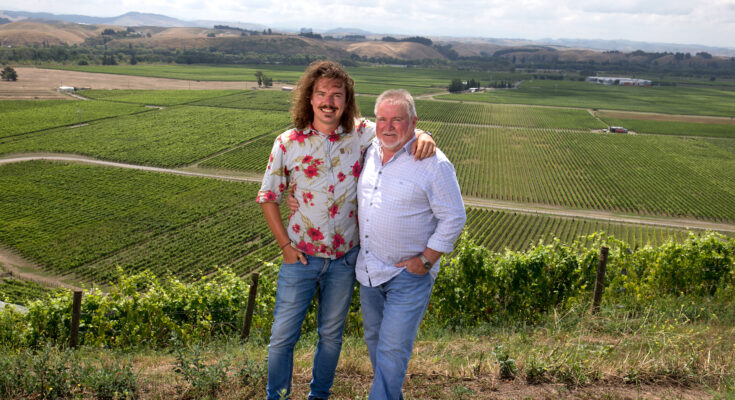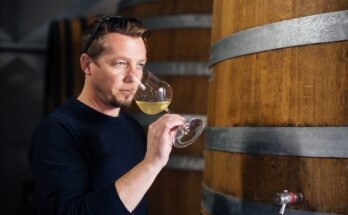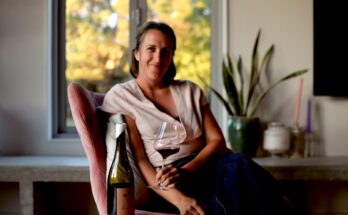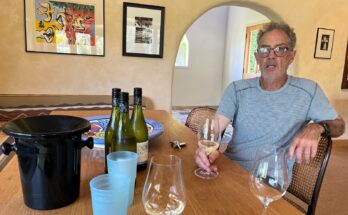At the end of June this year, I sped down to Hawke’s Bay to catch up with a few winemakers – old and new, and see how they had got on with the latest vintage under COVID restrictions, and talk about plans for the future. At the end of one particularly busy day, I settled in at John Hancock’s place to see what he’d been up to…
John Hancock: “I didn’t make any wine this year apart from Chardonnay. I did, but I sold it to Moana. Because I’d got little bits of stock and I thought with COVID and all the rest of it I don’t really want to be building up bottle stock. I’ve learnt that lesson. You get excess stock and you’re carrying the cost – storage and finance costs, it can be a killer.
That’s where Marlborough is lucky. I don’t think they’ve all got it right of course, otherwise they’d all be doing really well. I think they’ve undersold in a lot of cases – in terms of price. Take a look, I’ve just seen today some of the en primeur from Bordeaux – the Sauvignons coming out and they’re at least twice the price of New Zealand – and why? It would be interesting actually because I have no idea what sort of volumes of sauvignon and semillons might be out of Bordeaux”.
WineFolio: One of the things I’m looking at in terms of ‘themes’ that I want to write about is how we buy and sell wine – what are the drivers?
JH: Yes – why is someone happy to pay $9.99 for a rosé and then someone else will pay $90?
WF: When I was at Terra Sancta and they told me they want to make the best rosé in the world. We’ll start here and make the best rosé in New Zealand. So they’re putting their oldest vines’ grapes into rosé. I think it’s called First Vines, and I wasn’t sure if it was young vines – as in first crop… but no, it’s their oldest vines.
JH: and what are they selling it for?
WF: I think it was $40 or $50?
JH: Well you can’t even sell top Chardonnay for that, so good luck to them. And you’ve got to really earn it. Look at Homage – that’s taken twenty years, and it’s still only small quantities.
WF: They’ve changed the label again. I did prefer the old, old label – back in 2010 for example.
JH: The Americans wouldn’t live with that. Apparently they took the design of this label away from New Zealand and did it all in the States.
WF: and now they’ve got a screwcap on it, so how’s that going to go down in America?
JH: Well I was always against screwcaps. Not to say that a screwcap might not be a better answer for the wine. But for the image and marketing point of view. It has to be cork.
WF: Well I was surprised. It caught me by surprise actually – I didn’t realise it was on the cards.
JH: what did you think of the wine?
WF: The ’18? Erm, it was really good. Quality. What you’d expect.
JH: It’s had some quite good write ups. Joelle reckons it’s the best Homage yet. I haven’t seen it so I’m not really sure. It would have to be pretty good to be the best one.
WF: It’s a very smart wine, but is it the best one they’ve ever done? If I had to put the ones I’ve had, just on this trip, side by side I’d say that Rod McDonald’s Trademark was as good, and Kate Radburnd’s was perhaps the best. Hers was very complete and beautiful, already.
JH: I’ve tried the ’17 Homage. Personally I was always against releasing that. Not that the wine’s not good. But ’17 was regarded as not a very good year. 2013 and 2015 would be good years.
WF: I had a 2015 Gimblett, and that was good. That’s a clever wine.
JH: I very much like The Gimblett. Right from the first one which was 2005. That wine is one of the better value reds in the country. It’s a $100 bottle of wine for thirty.
WF: I went to a big ‘Fine Wines of New Zealand’ tasting last year and that stood out. I’ve still got the list where I was making notes, and it’s got a big circle around it. Not just because of price. It just stood out.
JH: Syrah, it’s Hawke’s Bay’s best wine, probably. But man it’s hard to sell. Tough gig.
WF: Isn’t it more of a point of difference though than, say, a Bordeaux Blend – more Hawke’s Bay specifically?
JH: Maybe, but people aren’t necessarily looking for a point of difference. I think they stick to the same. So a Bordeaux blend is much easier to sell than a Syrah.
WF: That’s interesting – and that $30-40 market is so congested as well isn’t it?
JH: Always. When we first came out with those wines in 1998 was it? 1997 was the first vintage we made Gimblett Gravels wines. Those wines were the same price then as they are now. That says one thing, maybe. Perhaps we were overpricing it in the first place.
WF: Let’s try some of your wines!
JH: sure – this is new – the ’19 Rosé – we’ve just released it now. It’s 100% Cabernet Franc, from Bridge Pa. It’s from the same vineyard that produces that Pyramid Valley Cabernet Franc.
WF: Is it? From the Howell vineyard? How much Cabernet Franc is there around? I like it – on it’s own.
JH: There’s a bit. Trinity’s got a reasonable amount. Grown well it makes a really good wine.
WF: Beautiful colour. I hate those ones where it looks like someone’s dropped a packet of lollies in it…glowing pink. That’s the colour a rosé should be.
JH: That’s how it is, it’s not been messed with at all. And its actually machine harvested, straight into the press, squeezed out and that’s it! Just on skins from the vineyard to the press, we don’t hold it on its skins or anything. The previous one was hand picked and whole bunch pressed. And an almost identical colour. It didn’t make much difference, except $700 a ton less. The new machines are great. At Moana Park we put in a sorting machine at the winery. It’s not an optical sorter – one of those Pellencs – it’s an engineering feat.
WF: I’m not a big rosé drinker. I’m traditional, I like it in Summer, with food. In a restaurant, with a plate of fish. And people will comment on it “I thought you were Mr Chardonnay?” but I do like it in the right setting.
JH: Well it’s such a versatile wine. You can drink it on it’s own if you want quite happily – and people obviously do, in substantial volumes. It used to be a 3 month thing – summer only, but now its spread much more widely than that.
WF: And I know people who drink it all day. Well, not ALL day obviously, but into the night. Whereas for me it’s a lunchtime drink. Who’s your market for it? It’s a got a very pretty label.
JH: Well, who do you think? The Havelock North Ladies. In fact our two biggest outlets for that, and we don’t have a lot. Deliciosa in Havelock North does it by the glass and it sells. That’s a great little place and all the winemakers tend to congregate there pretty regularly. And The Urban Winery – they go through a couple of dozen a week.
WF: I think Aucklanders would like that too – especially with that label – that’s a smart move having that on there.
JH: We call it Lillies because we were looking at family history, and my great great great grandparents came out to Australia from Cornwall in 1861 I think it was. And the ship they came out on was called Lillies. And funny, as we were harvesting the stuff those lilys were flowering at the side of the road next to the vineyard.
This is the 18 and the 19 – we’ve still got a reasonable amount of the 18 left.
WF: Different colours?
JH: Yeah, part of that will be the hand-picked versus the machine picked again. You tend to get a little bit more colour with machine harvesting.
WF: Really, well that’s something I didn’t know. I’m surprised!?
JH: They’re predominately stainless steel, a bit of barrel ferment. They’re very similar.
WF: I like the Moana Park Chardonnays, they’re good – you make those as well? And they’re so cheap!
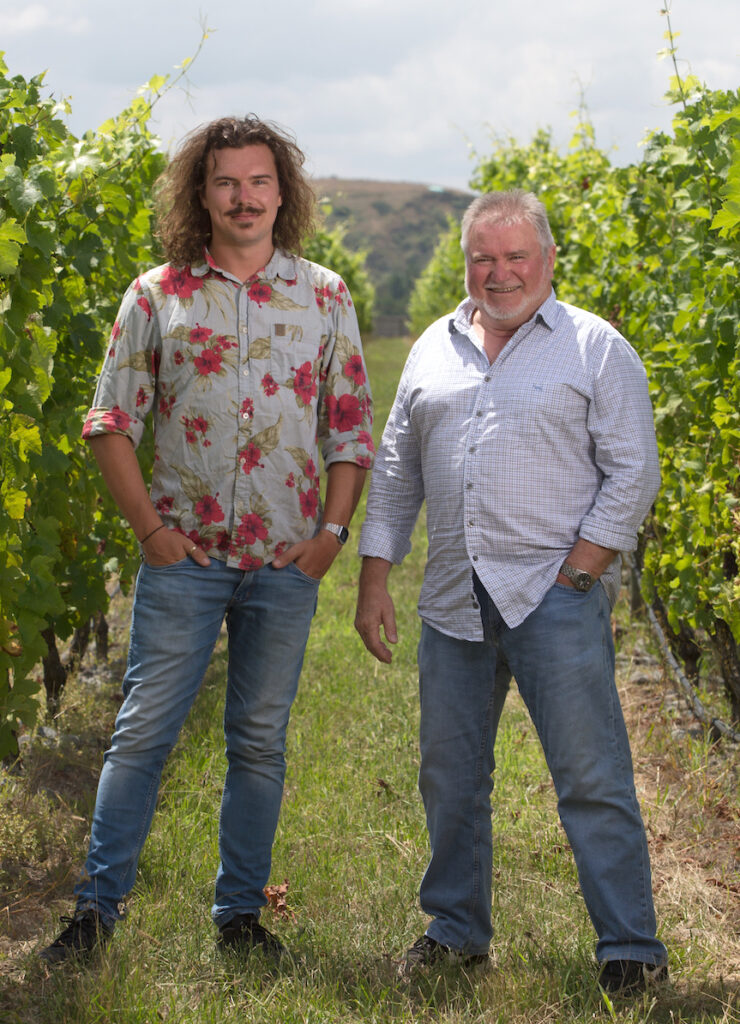
JH: Yes, sadly. The new branding is Moana, not Moana Park, and they’ve just come out with a couple of bubblies which have got the new label on it. They look quite good. A good step in the right direction.
WF: And your label is Hancock & Sons..?
JH: Yes, there’s one upstairs, he’s based in Wellington actually. And then there’s the winemaker one. He works with Rod out at Hawke’s Bay Wine company. And we get together and chew the fat about these and what we’re going to do. These are both a blend of – in fact I think the ’18 is all Clone 95 – the ’19 is partly 95 and partly Clone 15. From Paritua in Bridge Pa. I think the ’19 is going to develop quite nicely. That ’18 is really only just starting to open up at all, now. Tried to get away as much as possible from that ‘matchsticky thing’. I didn’t personally but a lot of people got a bit carried away with that I think. Hugh was one of them – those Legacy wines, a couple of them, the vintages were a bit extreme.
WF: Those big monsters can be hard work, yes. But he really nailed his colours to the mast with that style didn’t he? I mean, now it’s considered the modern style; but back in day it was considered a fault, and you’d have your wine thrown out for that.
JH: Absolutely. And I’m still inclined towards thinking that it is – to a degree – as well. Even though some winemakers encourage it, I think doing it a lot less now than they used to. Sometimes you have to take things to the extreme. I was the person in New Zealand who did full-on barrel fermentation before anyone else was doing it – certainly commercially. And we made the thing as big and brutish as we could – that was the whole idea. And then you tailor that, and wind it back until you get it to where it needs to be. Sometimes you can’t do that without going to the extreme.
WF: I’ve had the Church Road Grand Reserves for a few vintages now, and they’ve definitely dialled that back. It’s brought it more into balance in my opinion. These chardonnays of yours are nicely balanced too.
JH: I have a tendency not to get the wines too high in acid. I like the Chardonnay to be nice and soft and round. Still with good pH, but not those high acids. One of the Aussie writers, said they’d opened one of these Yarra Chardonnays that had been really pushed at the time by the critics, and they all thought it was bloody wonderful, and he said ‘it’s just gotten harder and harder – it hasn’t improved at all’. And they really chase that in the Yarra and Mornington Peninsula. People like Tom Carson who’s a big buddy of Warrens’ actually, and that pushed Warren down that way for a year or two.
WF: Rule no.1 it’s got to be delicious. For me, rules no.2 and 3 are probably balance and texture. Some people it’s all they talk about is texture. Texture is the thing that gets it further down the line to greatness.
JH: I totally agree.
WF: So how do you achieve really good texture in Chardonnay?
JH: With Chardonnay it’s really the lees contact.
WF: So what do you think of these egg fermenters then? Because then the lees all suspended isn’t it?
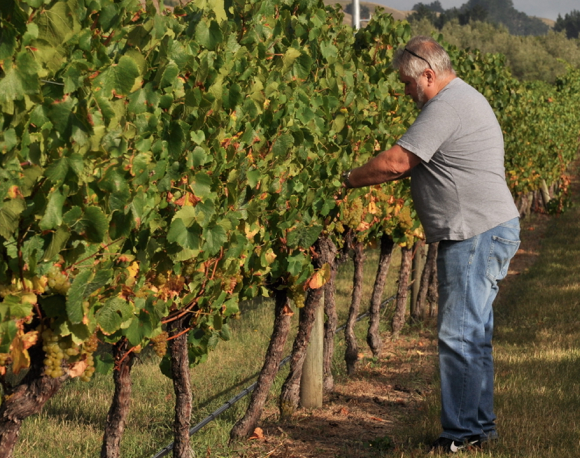
JH: Is it?
WF: Well I don’t know, I’m a writer. Maybe it’s all just some sort of witchcraft.
JH: I’m not interested.
WF: So you like your barrels?
JH: Yes, and I’m sticking with 225s. Not least because they’re easier to handle than 500s or 600s, but it’s traditional and I’m a Burgundy person. I was lucky enough to work at Domain Prieur under Jacques Prieur. They’re a small producer in Meursault who have something like eleven Grand Cru vineyards. From Chambertin down to and including a decent slab of Montrachet, so I really enjoyed that. Martin Prieur worked all round the world, and every night after work he’d pull out a whole bunch of wines and they wouldn’t necessarily be Burgundies – they’d be wines from all over the world. One night though was ten vintages of the Le Montrachet. That was a fascinating little tasting.
Can’t guarantee what this will be like, it’s still very early days, but it has been filtered. It’s knocked it around a little bit.
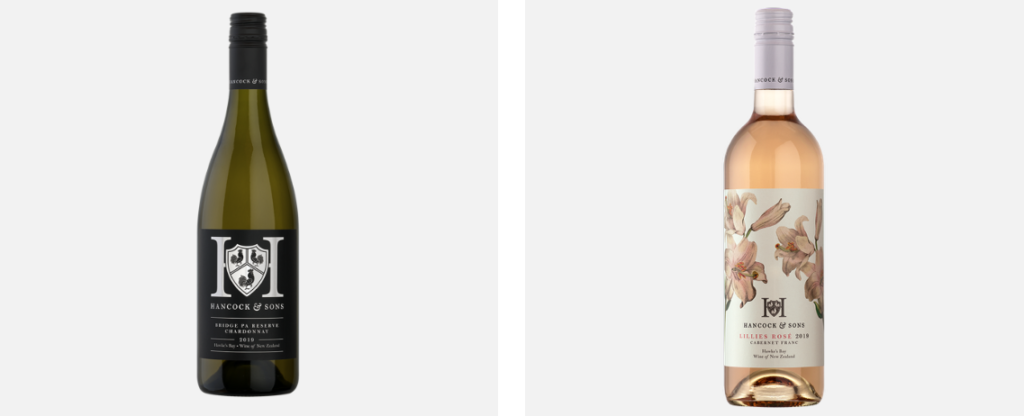
WF: I was interested to try this, it sounded intriguing.
JH: There’s only 4 barrels of it. We put out a little en primeur thing for it. 2 first orders – one was Kate, and the other was Rod McDonald!
WF: It’s a big boy Chardonnay this one – really rich and textural. I can taste the new oak in it – it’s got ‘reserve’ written all over it. Full Malo?
JH: No malo. But it has no malic acid. I use a yeast that degrades malic acid. Drops the acidity down. I like it. That what we started and always used in Morton in the early days. That Black label Chardonnay used that particular yeast. So this is not indigenous, uninoculated at all.
WF: So you’ve tricked me there! And you built it this way. I would have said full malo. It’s certainly creamy, textural. I love this wine – that’s going to be a cracker. It’s one of the nicest Chardonnays, that I’ve not had before, in a long time. I think this will go very well. I like that it’s luscious but then it’s got that drying element at the finish. Very classy, it’s lived up to my expectations.
JH: With the low acidity it almost tastes sweet, although it’s definitely got no sugar in it at all. That’s what I was after. I want a plush mouthfeel to the wine, not a screaming acidity. You need structure.
WF: I do love me a Chardonnay. I have this list in my head of my favourites, and the problem is when you find a new one, that could be a contender.. then one of the others has to drop out. And they’re like family – how do you choose your favourite child?
JH: With the Fine Wines of New Zealand – you have to have a bit of provenance, you can’t just be a one-off. One of the criteria is you have to have a certain number of vintages – you have to earn a place.
WF: I like that list. There’s not much I disagree with on there. And if you started at the top and worked your way through you’d be doing yourself a good turn there.
JH: This next wine is 80% Cabernet Franc Bridge Pa, and 20% Gimblett Gravels Cab Sav. This is the Howell Vineyard again.
WF: I really liked the Cabernet Franc from Smith & Sheth that was from there. And I liked the Syrah too, really fresh and focussed – I know Mike Henley was at Trinity, and a couple of those wines I can really see echoes of Trinity Hill in them, to me. I love this wine, but I do like Cabernet Franc a lot. I wish there was more of it around. And that bit of Cab Sav in there has really giving it nice structure, bit of tannin.
JH: The 2019 was planned to be 100% Cabernet Franc, and it looked good in barrel, but it’s not been an easy sell. $30. Not easy. We’re changing to silver on black for the next one, and moving to a Burgundy bottle.
WF: I like the black on black label – very smart. It reminds me of that Pask Declaration label, which I think is good. Classy. Part of my background is in design, so I always look for what’s on the label. And my tourism work is still my main focus. I know people are saying ‘oooh tourism is going to fail’ but I don’t reckon it will be as bad as we think.
JH: I’ve got a gut feeling that none of it is going to be as bad as people said. Having said that, I see today that Qantas were laying off six thousand people? They got a massive spike in cases. People are just stupid aren’t they?
WF: One positive is that it’s go people talking openly about things they don’t normally talk about. Even politics. I don’t think there’s enough rational discussion about that in New Zealand. And the more it’s discussed, the more accountable the politicians will be held to. Also, with the COVID-19 pressures I thought it was important to come down to Hawke’s Bay now, so that I can tell some stories ready for people to come out and visit in the Spring and Summer. Wine Tourism is a great thing to do when you’re travelling New Zealand because a vineyard and a Cellar Door is a lovely place to spend an hour or two.
JH: Moana has a nice little Cellar Door and they do pretty well there. They do encourage the buses, and it’s no more than ten minutes from Church Road and Mission. The Puketapu Tavern is nice little country pub with good food.
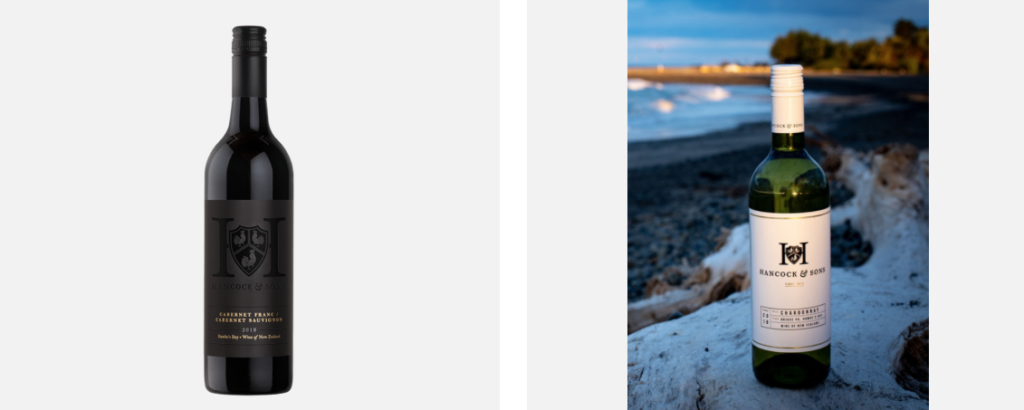
WF: Coming back to this Cabernet Franc, I like that edge of resinous to it – not in a bad way, slightly balsamic. It’s got something of that green whole-bunch vibe to it. What do you think about that, because it can be polarising – the profile that whole bunch can add to a wine?
JH: This isn’t whole bunch, but probably quite a lot of whole berries. Destemmed but don’t crush. I’m not a big fan of it, that whole bunch thing. I’m not sure for me that that’s the direction. I definitely wouldn’t have gone there for Homage. Warren’s really keen on it. Quite a few of the Syrah producers around us are all fiercely in love with Jamet – a Cote Rotie producer and he does quite a lot of whole bunch.
WF: the theories I’ve heard are along the lines of ‘you either do it boots and all, or don’t do it – you don’t dabble’. So don’t use 15% whole bunch, which just makes that a feature of your wine. Do it 100%, and then it’s integrated into the wine – it is the wine. Like using too much oak – we want balance. I’d say that after Rule no.1 – Delicious! we want Balance and Texture?
JH: Absolutely agree. Balance being no.1.
WF: Ooooh, no – delicious is always no.1!!! Balance and texture right there though. I haven’t done any judging, but if I did, that’s what I look for.
JH: Well it’s never that black and white you know? It’s an opinion – on that glass at that time. I met a guy at a wedding back in Australia in February – Mark Malouf and he has this things called ‘Wine worth writing about’ and he has fabulous descriptors of the wines.
WF: I find blind tasting very hard! I’ll often go ‘this is syrah’ but I’m not sure that it’s not a Pinot! Because I find some are so close these days! And I never win those blind tastings or options things. I just second guess myself.
JH: I tell you what, as you get older it gets more and more difficult. You just lose the edge. I don’t taste anywhere near as well as I used to. I’m Australian and in those early days, my early vintages were in Australia. My graduation year – I graduated at the end of 1973. I was one of the few guys in my year who didn’t have a job the whole time I was at Roseworthy, and I basically fell into the best job of the lot – of anybody, because everybody else was already taken, and I worked at Leo Burings. They were the leading white wines producer in Australia, and a guy called John Vickery who was voted the winemaker’s winemaker – the greatest of all time by the winemakers in Australia. And he was my first boss. I love Eden Valley. If I’d have made a lot of money doing wine – not that anyone does – I’d have gone back to Eden Valley. Not only the Riesling, but the Shiraz from there is bloody fantastic.
It’s interesting that when I was still there people didn’t own vineyards on their own – they were part owners and had a little block of grapes on their farm. That was how most of it was. It wasn’t just grape growing – they were farmers as well. And most of the vineyards were pretty small, apart from things like Yalumba in Pewsey Vale that was quite substantial. Significantly different from the Barossa floor.
WF: New Zealand still has lots of potential though, and hopefully Climate Change won’t bugger up that long growing season that we have, and end up too hot and ripening too quick.
JH: I guess the biggest issue is there’s not that many areas where there’s sizeable slabs of land for growing grapes. I think one of the last potential areas is central Hawke’s Bay. When Frank Yukich at Montana was looking to expand dramatically, and they had vineyards largely in Gisborne – Frank looked seriously at Central Hawke’s Bay. And this is before Marlborough. When they applied to plant it, they had so much objection from the local farmers, and he decided it was all too hard and went to Marlborough. It’s got really good potential, and it’s quite a lot cooler than here. Frost is an issue, but it is in a lot of parts of the world.
At Trinity we worked with a vineyard down at Porangahau – directly east of Woodville. Lovely Pinot and Sauvignon – the Sauvignon was great. It worked really well but it’s just too isolated. In the Trinity days, Colin Reynolds who was a property developer flew us down there in a helicopter to have a look at Waitaki because he wanted to get a whole bunch of land. And I though ‘this isn’t for me’ – I didn’t get a good feeling about it at all. It didn’t say ‘buy me’ to me.

